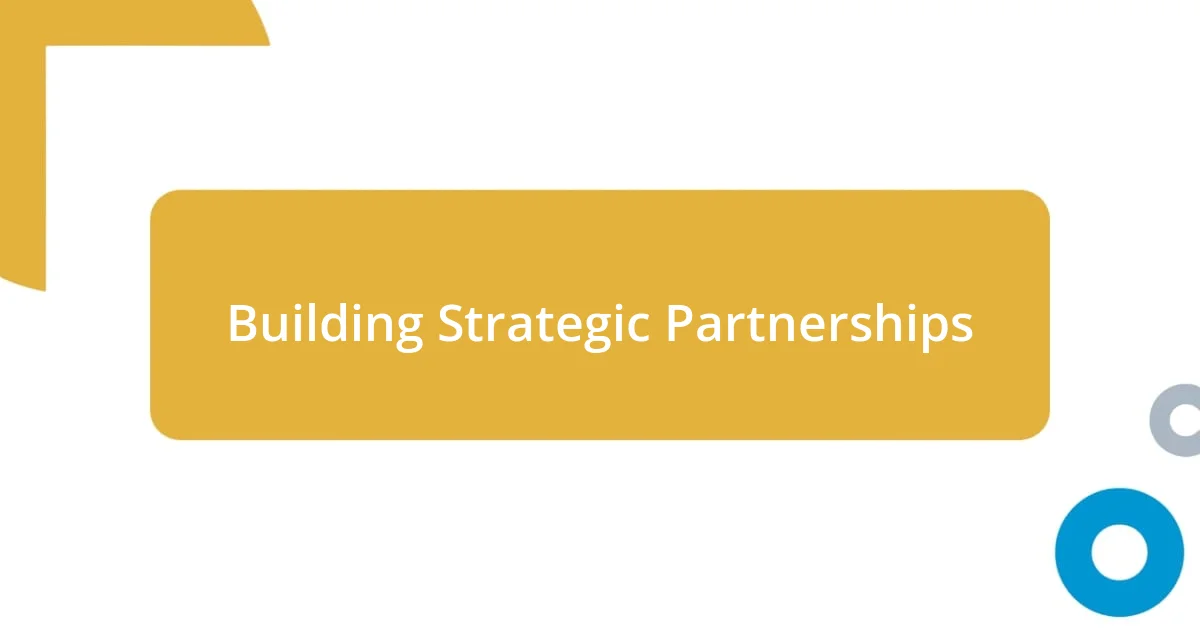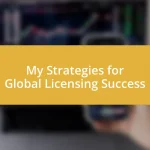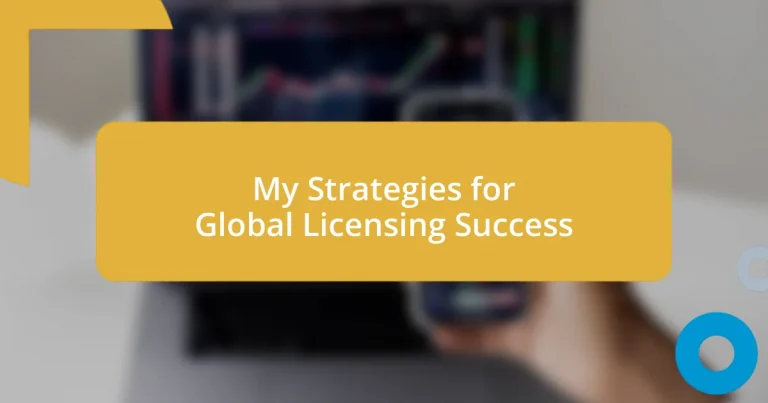Key takeaways:
- Understanding cultural nuances and compliance with local regulations are essential for successful global licensing.
- Building strong partnerships and clear communication in licensing agreements fosters trust and addresses potential challenges effectively.
- Continuous measurement and adaptability to market feedback are vital for refining marketing strategies and achieving success in global expansion.

Understanding Global Licensing
Global licensing can seem like uncharted territory, but when I first dipped my toes in these waters, everything clicked into place. I learned that it essentially allows one party to leverage the brand, products, or technology of another in various international markets. Have you ever thought about the power of your brand traveling across borders? It’s exhilarating!
From my experience, understanding the cultural nuances of each market is crucial. On one occasion, I was about to launch a product in Asia without considering local customs and preferences. Thankfully, I caught that oversight just in time. This taught me how deep the connection between licensing and local cultures runs.
I often reflect on the importance of compliance with international regulations when pursuing global licensing opportunities. Navigating this landscape feels like solving a puzzle; each piece represents a different country’s laws and consumer behavior. Do you remember the last time you faced a compliance challenge? Those moments can teach us invaluable lessons about diligence and adaptability.

Researching Target Markets
Researching target markets is a vital step that can significantly impact the success of your licensing strategy. I remember when I was considering a partnership in South America; I thought I had a solid plan in place. However, diving into local trends, consumer behaviors, and even social media dialogues made me realize that what worked in North America wouldn’t resonate the same way. It was like seeing the market through a whole new lens, and it ignited a passion for understanding varied cultural landscapes.
To effectively research target markets, consider the following strategies:
- Analyze demographics: Understand age, gender, income level, and education to tailor your approach.
- Explore cultural preferences: Delve into local traditions, values, and lifestyle choices to align your brand message.
- Utilize digital tools: Leverage data analytics, social media insights, and online surveys to gather real-time feedback.
- Study local competitors: Investigate what others are doing, identifying potential gaps or opportunities in the market.
- Engage with local experts: Build relationships with market insiders who can provide invaluable guidance and insights.
This process not only equips you with critical knowledge but also prepares you to navigate the complex landscape of global licensing with confidence and intention.

Developing Strong Licensing Agreements
Developing strong licensing agreements is not just about contracts; it’s an opportunity to foster lasting partnerships. I recall a pivotal moment in my career when I negotiated a licensing agreement with a company in Europe. Sitting at that table, I realized that mutual trust and understanding were as crucial as the terms we were discussing. This experience taught me that creating agreements rooted in collaboration leads to more fruitful outcomes.
As I went through various licensing negotiations, I found that clear communication is essential. Ambiguities in a contract can lead to misunderstandings and conflicts down the road. In one instance, we faced a considerable issue stemming from vague language regarding royalties. That situation taught me the importance of precise wording and the value of double-checking every detail. Strong agreements clearly outline responsibilities, duration, and exit strategies, reducing potential friction in the relationship.
In my journey, I often encountered the need to tailor agreements to fit cultural contexts. For instance, while working on an innovative technology license in Asia, I found myself researching local business norms. The nuances I learned about negotiation styles and expectations made all the difference. So, always remember that a successful licensing agreement adapts to the partner’s cultural landscape.
| Key Aspects | Details |
|---|---|
| Trust and Collaboration | Fosters lasting partnerships and smooth negotiations. |
| Clear Communication | Reduces ambiguities, ensuring all parties understand obligations. |
| Cultural Adaptation | Tailors agreements to fit the nuances of different markets. |

Navigating Regulatory Compliance
Navigating regulatory compliance can often feel overwhelming, but I find it to be a crucial aspect of successful global licensing. I vividly remember a moment negotiating a deal in a country with strict import regulations. I realized that being well-versed in local laws wasn’t optional; it was a necessity. It’s like setting sail on a ship without knowing the hazards of the waters—you wouldn’t dream of doing that, right?
Each market has its own regulatory landscape, filled with unique nuances and requirements. I’ve spent countless hours studying everything from intellectual property laws to safety standards. In one instance, while evaluating a potential licensing opportunity in Europe, I discovered their stringent consumer protection laws. It struck me just how vital it is to ensure that all products meet the legal standards, not just to avoid penalties but to build trust with consumers who rely on compliance for their safety.
I often ask myself how companies manage to stay compliant while innovating simultaneously. In my experience, the best approach has been to develop strong relationships with local legal experts. They can provide insights that go well beyond the black-and-white text of regulations. I remember having a candid conversation with a local attorney who pointed out not just what was required legally, but also what consumers expected culturally. That insight helped me frame our product strategy in a way that honored both compliance and customer expectations, ultimately paving the way for success.

Building Strategic Partnerships
Building strategic partnerships is crucial for licensing success. I often reflect on my first partnership with a smaller brand—at first, I was skeptical of their reach, but I soon discovered their passionate focus on niche markets opened doors I hadn’t considered. Isn’t it fascinating how sometimes the smallest players can create the biggest impact? This taught me that a partnership isn’t just about size; it’s about shared vision and complementary strengths, enhancing both parties’ capabilities.
It’s essential to invest time in understanding your partner’s goals and values. I vividly remember a meeting where we aligned our visions for the future. There was a spark of excitement as we realized we could co-create products that went beyond our expectations. That moment solidified my belief that shared aspirations can lead to innovative outcomes. Isn’t synergy what we’re all searching for in partnerships?
Regular check-ins can keep the momentum going and proactively address challenges. I learned this the hard way when a potential red flag popped up in a past collaboration. If we had talked openly about the issue sooner, we could have avoided a significant delay in our project. Continuous communication not only reinforces trust but also nurtures adaptability, allowing both parties to thrive amidst change. How do you keep the lines open and vibrant in your partnerships? For me, it’s all about creating an environment where both sides feel comfortable sharing ideas and concerns.

Implementing Effective Marketing Strategies
Implementing effective marketing strategies requires a keen understanding of the target audience and the unique cultural contexts in which you’re operating. I remember when I launched a product in Asia; the initial marketing plan was built around what worked in western markets. However, as I delved deeper into local consumer behavior, I realized my messaging needed a complete overhaul, turning from a focus on luxury to one that highlighted sustainability, which resonated more strongly with local values. Isn’t it interesting how adaptability can make or break your success?
Social media is another powerful avenue for marketing, especially when entering new global markets. During a campaign for a tech accessory, we leveraged influencer partnerships that aligned with local tastes—something I hadn’t considered before. One influencer’s endorsement transformed our initial sales forecasts; their authentic connection with followers created a genuine buzz that we couldn’t replicate through traditional advertising channels. How often do we underestimate the impact of grassroots marketing?
Lastly, tracking and analyzing data is vital to refining your strategies. After launching a product in South America, I was surprised by the demographic differences in engagement metrics compared to other regions. It prompted me to adjust our targeting focus and engage more deeply with local trends. I’m continually learning that data isn’t just numbers; it tells a story about consumer preferences that can guide your next steps. Isn’t it amazing how the insights gathered can illuminate the path forward?

Measuring and Adjusting for Success
Measuring the success of your licensing strategy is a continuous journey. I recall the first time I rolled out a product in Europe; we set up key performance indicators (KPIs) to assess everything from marketing reach to sales figures. I thought I had everything covered until I discovered that customer feedback was the real gold mine. Isn’t it striking how sometimes the numbers can’t capture the full story? That’s when I learned to incorporate qualitative insights as part of my measurement toolkit.
Adjustments are essential for ongoing success, especially when initial strategies don’t yield the expected outcomes. In one instance, after our product launch in Australia, I was disheartened to see traction lagging behind projections. Rather than sticking rigidly to the plan, I listened to feedback and pivoted our approach, focusing on educational content that connected with consumer needs. It’s amazing how being flexible can transform a setback into an opportunity for growth and connection, don’t you think?
I find that consistent evaluation helps me stay aligned with market dynamics. After all, consumer preferences can shift rapidly. I vividly remember a significant update we had to make when we realized our previous marketing approach was missing the mark in one region. By implementing regular review sessions, I not only adjusted our tactics but also fostered a culture of openness and creativity within my team. How do you measure success in your own strategies? For me, it’s about embracing an adaptive mindset and viewing each adjustment as a chance to innovate and evolve.












